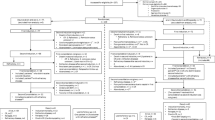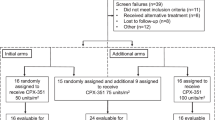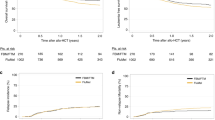Abstract
Although cytosine arabinoside (AraC) represents the most effective single agent in the treatment of adults with acute myeloid leukemia (AML) when given at doses exceeding 200 to 500 mg per application, its optimal dosage is still a matter of controversial discussion. While pharmacokinetic investigations suggest that the AraC-activating enzyme deoxycytidine kinase is saturated at drug concentrations achieved by short-term infusion of 0.5 to 1.0 g/m2 AraC and that higher doses are therefore not more effective, recent evidence indicates that additional mechanisms of AraC cytotoxicity may exist which could be enhanced by further dose escalation. In order to test this thesis in the clinical setting, a prospective randomized comparison of high-dose (HD-AraC) vs intermediate-dose (ID-AraC) AraC was carried out in patients with refractory or relapsed AML on the basis of the sequential high-dose AraC and mitoxantrone regimen (S-HAM). AraC was given as a 3-h infusion q 12 h on days 1, 2, 8 and 9. Patients younger than 60 years were randomized to AraC doses of 3.0 g/m2 vs 1.0 g/m2 while older patients received either 1.0 g/m2 or 0.5 g/m2 per single dose. Mitoxantrone was given to all patients on days 3, 4, 10 and 11 at a daily dose of 10 mg/m2. Randomization was stratified for primary refractoriness against induction therapy and length of first remission in relapsed patients. From 186 evaluable patients, 88 (47%) and 10 cases (5%) achieved a complete (CR) or partial (PR) remission, 39 patients (21%) had persisting leukemia (non-response (NR)), and 49 cases (26%) died within 6 weeks after the start of therapy (early death (ED)). In patients younger than 60 years the higher dose level resulted in a significant reduction of NR (12% vs 31%; ordinal χ2 test: P = 0.01) but also a higher rate of ED (32% vs 17%) thus leading to a marginally higher CR rate only (52% vs 45%). Within the subgroup of patients with refractory AML the tendency towards a higher CR rate after HD-AraC was more pronounced (46% vs 26%; P = 0.045). In patients older than 60 years, corresponding though less evident differences were observed with a higher rate of NR in the lower dose group (26% vs 16%) and ED occurring more frequently after higher doses (36% vs 26%). These data indicate that HD-AraC reveals a significantly higher antileukemic efficacy than ID-AraC as expressed by a significant reduction of failure from NR. This advantage, however, does not fully translate into an increase in remission rate due to a higher incidence of ED after HD-AraC predominantly from uncontrolled infections. In order to take full advantage of the higher antileukemic activity of HD-AraC an improvement of supportive care and infection control is warranted.
This is a preview of subscription content, access via your institution
Access options
Subscribe to this journal
Receive 12 print issues and online access
$259.00 per year
only $21.58 per issue
Buy this article
- Purchase on Springer Link
- Instant access to full article PDF
Prices may be subject to local taxes which are calculated during checkout
Similar content being viewed by others
Author information
Authors and Affiliations
Consortia
Rights and permissions
About this article
Cite this article
Kern, W., Aul, C., Maschmeyer, G. et al. Superiority of high-dose over intermediate-dose cytosine arabinoside in the treatment of patients with high-risk acute myeloid leukemia: results of an age-adjusted prospective randomized comparison. Leukemia 12, 1049–1055 (1998). https://doi.org/10.1038/sj.leu.2401066
Received:
Published:
Issue Date:
DOI: https://doi.org/10.1038/sj.leu.2401066
Keywords
This article is cited by
-
Emerging agents and regimens for treatment of relapsed and refractory acute myeloid leukemia
Cancer Gene Therapy (2020)
-
Sequential treatment combining cladribine-based re-induction, myeloablative allogeneic HSCT, and prophylactic donor lymphocyte infusion: a promising treatment for refractory acute myeloid leukemia
Annals of Hematology (2018)
-
Salvage regimens using conventional chemotherapy agents for relapsed/refractory adult AML patients: a systematic literature review
Annals of Hematology (2018)
-
Long-term follow-up of the AML97 study for patients aged 60 years and above with acute myeloid leukaemia: a study of the East German Haematology and Oncology Study Group (OSHO)
Journal of Cancer Research and Clinical Oncology (2016)
-
Chemomodulation of sequential high-dose cytarabine by fludarabine in relapsed or refractory acute myeloid leukemia: a randomized trial of the AMLCG
Leukemia (2014)



